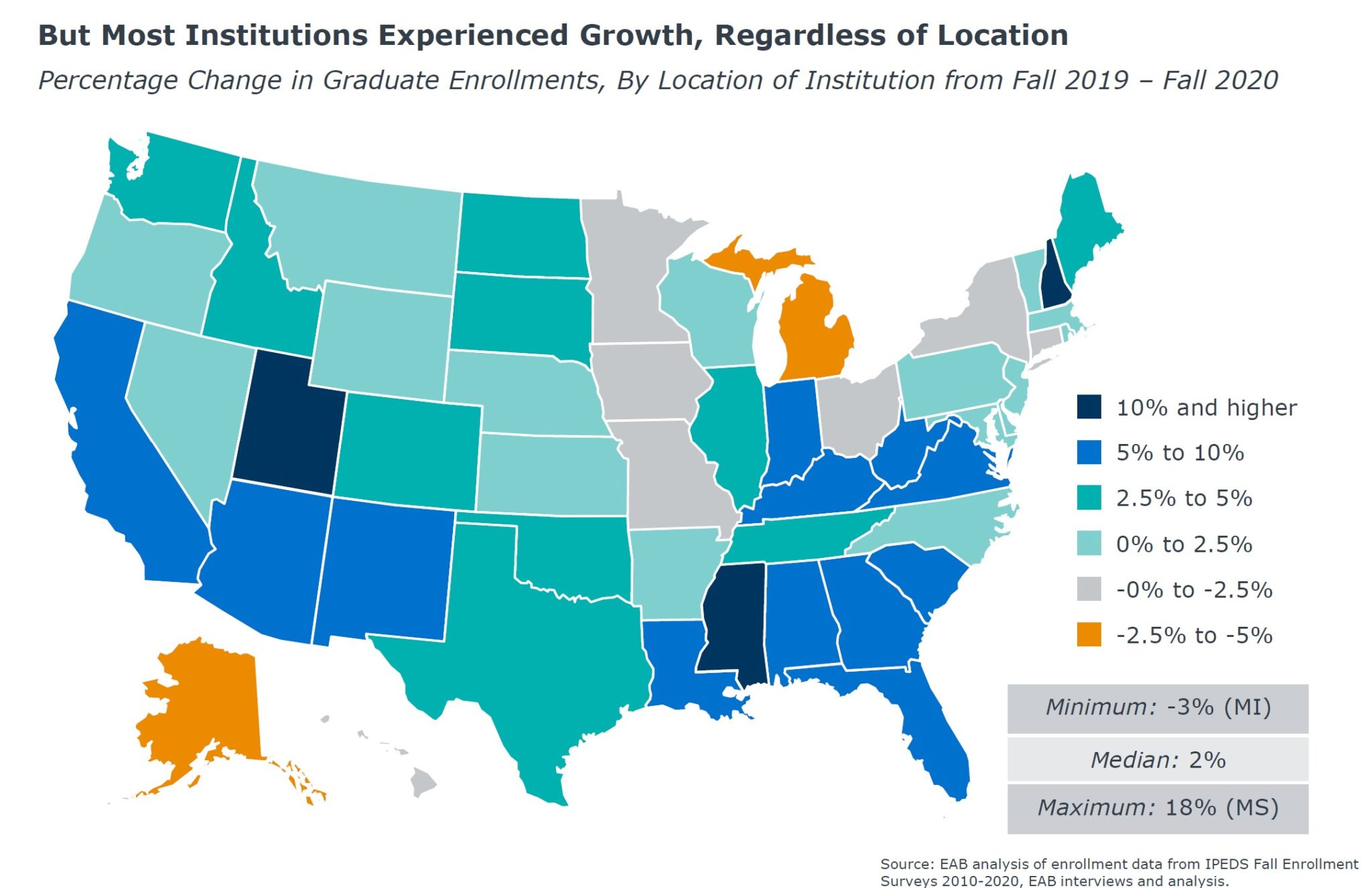Here’s what the institutions who grew grad enrollment in 2020-21 did right
Key takeaways from EAB’s latest research on the state of the graduate market
February 8, 2022, By Tess Arena, Director, Product Marketing
Growth in graduate enrollment across the last two years exceeded dreary pre-pandemic growth projections from the National Center for Education Statistics. Graduate enrollment expanded by 2.4% in 2020 and 2.1% in 2021, compared to 0.2% growth projected during this period.
But while nearly half of institutions experienced healthy graduate enrollment growth from 2019 to 2020, about one-third of institutions saw a decline in their graduate enrollments during this period.

What’s driving these trends-and what factors are separating the institutions whose graduate enrollment grew from those who experienced declines? Our researchers took a deep dive into the data to find out.
Online preparation and investment are paying off
Institutions that have been building robust online portfolios and infrastructure saw much of that work pay off in terms of total graduate enrollment growth in 2020. Our researchers found that institutions with a greater share of online graduate students pre-pandemic grew faster in 2020 than their peers. Seven of the top 10 institutions by increase in graduate enrollment are predominantly online institutions, including Grand Canyon University and Southern New Hampshire University. Arizona State, Georgia Tech, and Florida State, each with sizable online portfolios and investments, also experienced significant growth in total graduate enrollment from 2019 to 2020.
RESEARCH REPORT: DEVELOPING AND MARKETING ONLINE PROGRAMS SUCCESSFULLY
But the rule that online preparation catalyzed overall graduate enrollment growth didn’t just apply to the online giants. To understand how pre-pandemic online investment and experience paid off across schools of all sizes, our researchers grouped institutions based on the percentage of students who were enrolled online as of 2019. In doing so, we continued to see that the greater capacity an institution had for online graduate education in 2019, the greater its growth in 2020 across all graduate enrollments.

We have a few hypotheses as to why institutions with a greater capacity for online learning in 2019 experienced more growth in 2020 across all graduate enrollments:
- Polished online experience: We expect that students who believed they would be studying online preferred to go to an institution with a robust and seamless online experience.
- Able to enroll quickly: Many online institutions allow for quick enrollment and offer more start dates, therefore attracting students who were able to expedite their graduate school plans. More traditional institutions, however, may require students to submit applications nine or more months prior to enrollment-effectively ruling themselves out for fall 2020.
- Digital marketing experience: Many online institutions also spend more on digital advertising and marketing and therefore had the upper hand in a suddenly remote world.
3 MISTAKES YOU MIGHT BE MAKING WHEN MARKETING ONLINE PROGRAMS
How have for-profit institutions fared during the pandemic?
After much speculation during the early days of the pandemic about whether enrollment at for-profit institutions would grow, it’s clear that COVID-19 did not lead to a boom in enrollment for the for-profit sector. About half of for-profit institutions experienced a 2.5% decline in graduate enrollment – making for-profits the worst-hit segment of 2020.
Domestic diversity push provides a cushion while international enrollment slumps
It’s no secret that international enrollment declined during the pandemic. As the prospective international students we surveyed told us, travel restrictions, difficulties completing admissions requirements such as the Test of English as a Foreign Language (TOEFL), and the uncertainties instigated by the pandemic all stymied international enrollment. In total, the market lost 47,000 graduate students enrolling from outside of the US from fall 2019 to fall 2020. The decline in international enrollment is, in part, why highly ranked institutions experienced enrollment declines, as many of these schools had more international enrollments to lose.
Despite these declines, total graduate enrollment grew, in part, because of increases in enrollment among students of color domestically. In fact, growth in enrollment among Hispanic/Latinx, Asian, and Black students more than covered declines in international enrollment growth. These trends further suggest that institutions that make concerted efforts to grow diversity and opportunity in their graduate programs are also set up for enrollment growth.

There is some good news regarding international enrollment, however. International enrollments bounced back rapidly in 2021. Preliminary data suggests international enrollment grew an estimated 12.7% from 2020 to 2021.
Graduate growth was widespread across most corners of the US
Our team also examined state-level graduate enrollment data to understand which regions experienced this boost most significantly. The state-by-state data further suggests there is expanding market opportunity for most but not all.
The chart below is based on institutional location, rather than student location, and can provide insight into how your institution fared compared to in-state and regional competitors. In dark blue, you can see how graduate enrollments grew significantly in New Hampshire and Utah-fueled in part by graduate enrollment growth at Southern New Hampshire University and Western Governors University, respectively.

But we also saw some notable growth across the South, especially in Mississippi. And that’s not due to any outliers. Belhaven, Mississippi State, and Southern Mississippi University all added more than 600 graduate students in 2020. In absolute numbers, California added the most graduate students. Northcentral University and University of the People, both fully online institutions based in California, led the way, while Pepperdine and Brandman also added more than 700 students in 2020.
READ MORE STORIES OF SCHOOLS GROWING GRADUATE ENROLLMENT
By contrast, Michigan saw persistent declines in graduate enrollment. Thirty-one of the 48 institutions that enroll graduate students in Michigan lost students in 2020. In absolute numbers, New York lost the most graduate students at 2,983 fewer students in 2020 as compared to 2019.
YOUR FUTURE GRADUATE STUDENTS WILL BE HARDER TO FIND. HERE’S WHY.
Broadly speaking, COVID-19 was good for graduate enrollment. But not everyone received a windfall-and it remains unclear for how long the momentum in graduate enrollment will last. The institutions that can capitalize on this momentum and use these lessons to inform their long-term strategy will be best suited for future growth.

More Blogs

3 things you need to know about the shifting adult learner market

How Houston Baptist University tripled graduate student enrollment
